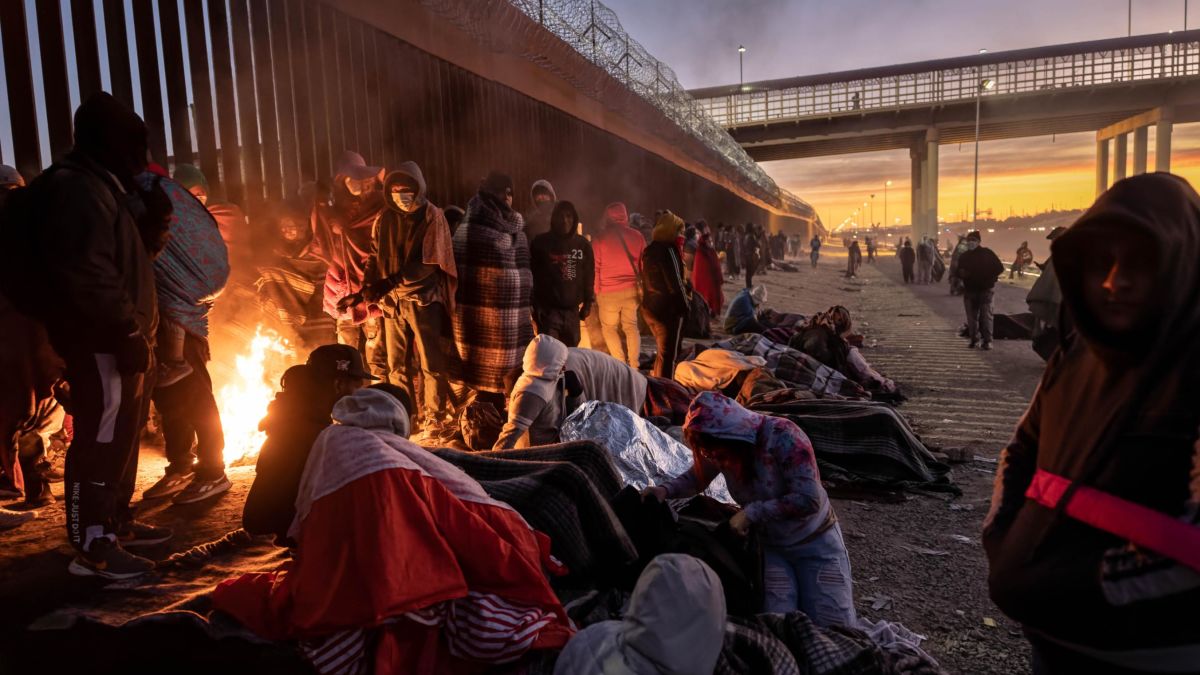(Trends Wide) –– The Supreme Court of the United States decided this Tuesday that the controversial border restriction known as Title 42, implemented under the Trump government, will remain in force while the pending legal resources are resolved. The move ensures that federal officials will be able to continue expeditiously expelling migrants at US borders for months to come.
The 5-4 decision represents a victory for the Republican-led states that urged the Supreme Court to step in and block a lower court opinion ordering an end to Title 42. The Biden administration has said it was prepared for the end of the order and that he had taken precautions to guard against confusion at the border and any possible surge of immigrants.

Asylum seekers line up to be processed by Border Patrol agents near Somerton, Arizona, on December 26, 2022. (Credit: REBECCA NOBLE/AFP via Getty Images)
The court also agreed to resume the states’ appeal this term. The court said it would hear arguments on the case during its pleading session that begins in February 2023.
Judges Sonia Sotomayor and Elena Kagan said they would deny the request, but did not explain their thinking. Conservative Justice Neil Gorsuch also dissented, explaining his arguments in an order joined by Liberal Justice Ketanji Brown Jackson.
Gorsuch said he “doesn’t dismiss the states’ concerns” about border security. However, he noted that Title 42 was put in place to combat covid-19 and “the current border crisis is not a covid crisis.”
“Courts should not be in the business of perpetuating administrative edicts designed for an emergency just because elected officials have been unable to address a different emergency,” Gorsuch wrote.
Since March 2020, Title 42 has allowed US border agents to immediately reject migrants who cross the southern border, under the argument of preventing covid-19.
Immigrant rights advocates and public health experts have long denounced the use of this public health authority at the US southern border, arguing that it represents an inappropriate pretext to bar immigrants from entering the country. . In nearly three years, the authority has been used more than 2 million times to turn away migrants, according to the US Customs and Border Protection (CBP).
At the border, migrants have been waiting for months inside camps in Mexico, anticipating the end of Title 42 so they can apply for asylum in the U.S. Immigrant advocates have tried to spread updates and information, but desperation has grown , especially as temperatures drop.
El Paso, Texas, has been at the center of the crisis as thousands of migrants have crossed that region of the border. The city opened government-run shelters at its disused convention center, hotels and several schools to care for those arriving, but some have still had to sleep on the streets amid freezing temperatures.
The Department of Homeland Security has put in place an action plan for when Title 42 ends, which includes increasing resources to the border, targeting traffickers and working with international partners.
Attorney General Elizabeth Prelogar acknowledged before the Supreme Court last week that returning to traditional protocols along the border would be challenging, but said there is no longer a basis for upholding the Covid-19 pandemic rules.
“The government in no way seeks to minimize the severity of that problem. But the solution to that immigration problem cannot be to extend indefinitely a public health measure that everyone now recognizes has outlived its public health justification,” Prelogar wrote in a Supreme Court filing.
Lawyers for the American Civil Liberties Union, which represents families subject to Title 42, underscored the dangers facing asylum seekers affected by the order and sent back to Mexico.

A US Border Patrol agent closes the doors of a van carrying asylum seekers at the US-Mexico border fence near Somerton, Arizona on December 26, 2022. (Credit: REBECCA NOBLE/AFP via Getty Images)
News in development…
(Trends Wide) –– The Supreme Court of the United States decided this Tuesday that the controversial border restriction known as Title 42, implemented under the Trump government, will remain in force while the pending legal resources are resolved. The move ensures that federal officials will be able to continue expeditiously expelling migrants at US borders for months to come.
The 5-4 decision represents a victory for the Republican-led states that urged the Supreme Court to step in and block a lower court opinion ordering an end to Title 42. The Biden administration has said it was prepared for the end of the order and that he had taken precautions to guard against confusion at the border and any possible surge of immigrants.

Asylum seekers line up to be processed by Border Patrol agents near Somerton, Arizona, on December 26, 2022. (Credit: REBECCA NOBLE/AFP via Getty Images)
The court also agreed to resume the states’ appeal this term. The court said it would hear arguments on the case during its pleading session that begins in February 2023.
Judges Sonia Sotomayor and Elena Kagan said they would deny the request, but did not explain their thinking. Conservative Justice Neil Gorsuch also dissented, explaining his arguments in an order joined by Liberal Justice Ketanji Brown Jackson.
Gorsuch said he “doesn’t dismiss the states’ concerns” about border security. However, he noted that Title 42 was put in place to combat covid-19 and “the current border crisis is not a covid crisis.”
“Courts should not be in the business of perpetuating administrative edicts designed for an emergency just because elected officials have been unable to address a different emergency,” Gorsuch wrote.
Since March 2020, Title 42 has allowed US border agents to immediately reject migrants who cross the southern border, under the argument of preventing covid-19.
Immigrant rights advocates and public health experts have long denounced the use of this public health authority at the US southern border, arguing that it represents an inappropriate pretext to bar immigrants from entering the country. . In nearly three years, the authority has been used more than 2 million times to turn away migrants, according to the US Customs and Border Protection (CBP).
At the border, migrants have been waiting for months inside camps in Mexico, anticipating the end of Title 42 so they can apply for asylum in the U.S. Immigrant advocates have tried to spread updates and information, but desperation has grown , especially as temperatures drop.
El Paso, Texas, has been at the center of the crisis as thousands of migrants have crossed that region of the border. The city opened government-run shelters at its disused convention center, hotels and several schools to care for those arriving, but some have still had to sleep on the streets amid freezing temperatures.
The Department of Homeland Security has put in place an action plan for when Title 42 ends, which includes increasing resources to the border, targeting traffickers and working with international partners.
Attorney General Elizabeth Prelogar acknowledged before the Supreme Court last week that returning to traditional protocols along the border would be challenging, but said there is no longer a basis for upholding the Covid-19 pandemic rules.
“The government in no way seeks to minimize the severity of that problem. But the solution to that immigration problem cannot be to extend indefinitely a public health measure that everyone now recognizes has outlived its public health justification,” Prelogar wrote in a Supreme Court filing.
Lawyers for the American Civil Liberties Union, which represents families subject to Title 42, underscored the dangers facing asylum seekers affected by the order and sent back to Mexico.

A US Border Patrol agent closes the doors of a van carrying asylum seekers at the US-Mexico border fence near Somerton, Arizona on December 26, 2022. (Credit: REBECCA NOBLE/AFP via Getty Images)
News in development…





:focal(0x0:3500x2333)/static.texastribune.org/media/files/05417cd32d19e75f1e9c7272aa8c1264/Robert%20Roberson%20IPL%20TT%2029.jpg)